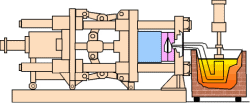Understanding Zinc Die Casting Process. It has been known that the best material used in die casting is the zinc because of its significant characteristics. So now, it’s time for you to know the simple process of Zinc Die Casting. But before understanding the Zinc Die Casting Process, it is important for you to have an idea about the different process of Die Casting.
The standard process of Die Casting has four stages:
1. Oil will be coated all over the mold. Afterwards, the machine will be closed. The coated oil will control the die’s hotness and it will take away the casting.
2. Under high pressure, between 1,500 to 25,000 psi, the die will then be injected with molten metal. After filling the molten metal with die, pressure will be retained, waiting for the casting to get hardened.
3. After that, the die will be opened, and with the use of ejector pins, shots will be ejected.
4. Lastly, with the use of a particular trim die, the flash, sprues, runners and gate included in scrap, will be removed from the castings under hydraulic press or power press.
Another process is called Pore-Free Casting, which is very different with Zinc Die Casting Process, but it can be done using zinc alloys. The method used is the same with the standard die casting process, but with Pore-Free, before every shot, oxygen is inserted within the die.
Now, let’s go to the Zinc Die Casting Process. In this process, the molten zinc will be injected all the way through a hot manifold to the hot mini-nozzles, directly to a molding cavity. Zinc Die Casting Process helps reduce the expense for each part by removing runners, gates and sprues as well as energy conservation. Also, it provides greater surface quality by means of a slow-paced cooling sequence.
Those are the different Die Casting process used by different die cast manufacturers.


